英文注释
英文论文注释和论文格式

论文注释和参考文献格式12.1注释Citations2.1.1夹注In-text Citations转述、阐释、总结他人主要观点、引用某些引文或所依据的文献无须详细注释者,以夹注的形式随文在括号内注明。
夹注与“参考文献”结合,形成一种方便、快捷说明引用出处的注释形式。
夹注的构成形式有以下几种情况:1)来自英语文章、专著的直接引语,作者姓名在文中已经出现:格式:出版年份:页码例:Rees said, “As key aspects of …in the process” (1986: 241), …2 ) 来自英语文章、专著的直接引语,作者姓名在文中没有出现:格式:作者姓名,出版年份:页码例:The underlying assumption is that language is “bound up with culture in multiple and complex ways”(Elli, 1968: 3).3 ) 来自英语文章、专著的间接引语,作者姓名在文中已经出现:格式:出版年份:引文页码例:According to Alun Rees (1986: 234)〔夹注直接放在被引者后面〕, the writers focus on the unique contribution that each individual learner brings to the learningsituation.According to Alun Rees,the writers focus on the unique contribution that each individual learner brings to the learning situation (1986: 234). 〔夹注也可以位于引语的最后〕4 ) 来自英语文章、专著的间接引语,作者姓名在文中没有提到:格式:作者姓名出版年份:引文页码例:It may be true that in the appreciation of medieval art the attitude of the observer is of primary importance (Robertson, 1987: 136).5)来自汉语文章、专著,间接引用,作者姓名在文中已经出现2:格式:作者姓名拼音+夹注(出版年份:引文页码)例:Wang Datong(2002: 111, 2005: 191) believed that…;6)来自汉语的文章、专著,间接引用,作者姓名在文中没有出现:1本格式主要参阅了APA,《外语教学与研究》杂志以及部分大学外语学院毕业论文格式要求;日语毕业论文格式另列。
英文缩写注释

DLL
n.
动态链接库
CMOS
n.
[计]互补金属氧化物半导体
BIOS
[`baICs]
abbr.
[计] Basic Input Output System 基本输入输出系统
IDE
[aId]
n.
集成电路设备, 智能磁盘设备
processor
[5prEusesE]
ISDN
n.
综合业务服务网
abbr.
Integrated Services Digital Network, 综合服务数字网
PSTN
(Public Switched Telephone Network)公共开关电话网络;一种常用旧式电话系统
DOS
[dU:z]
n.
磁盘操作系统
班长, 监听器, 监视器, 监控器
vt.
监控
v.
监控
standard
[5stAndEd]
n.
旗, 军旗, 标准, 规格, 本位
adj.
标准的, 权威, 第一流的
VPN
(Virtual Private Network)虚拟个人网络
adapter
[E5dAptE(r)]
n.
n.
处理机
处理器
AMD
美国AMD公司,主要生产计算机的CPU芯片
dual
[5dju(:)El]
adj.
双的, 二重的, 双重
core
[kC:]
n.
果核, 中心, 核心
Microsoft
英文注释MLA和APA格式

Modern Language Association为美国现代语言协会制定的论文指导格式,在一般书写英语论文时应当使用MLA格式来保证学术著作的完整。
APA格式简介一个为广泛接受的研究论文撰写格式,特别针对社会科学领域的研究,规范学术文献的引用和参考文献的撰写方法,以及表格、图表、注脚和附录的编排方式。
APA格式因采用哈佛大学文章引用的格式而广为人知,其“作者和日期”的引用方式和“括号内引用法”相当著名。
正式来说,APA格式指的就是美国心理学会(American Psychological Association)出版的《美国心理协会刊物准则》,目前已出版至第五版(ISBN 1-55798-791-2),总页数超过400页,而此协会是目前在美国具有权威性的心理学学者组织。
APA格式起源于1929年,当时只有7页,被刊登在《心理学期刊(Psychological Bulletin)》。
MLA和APA格式参考文献引用的规范应该按专业方向的不同选择使用MLA(the Modern Language Association)或者APA(the American Psychological Association),一般偏重人文学科的应用MLA,偏重自然学科的应用APA。
学位申请人应认真阅读相应的规范使用手册。
本节提供部分实例,供参考。
3.2 参考文献著录的格式参考文献著录在MLA规范里叫做Works Cited,在APA规范里叫做References。
撰写论文时应仔细阅读MLA或APA的规范手册,本节仅提供部分著录实例,供参考。
3.2.1 著录已出版的文章一位作者写的文章MLA:Stewart, Donald C. “What Is an English Major, and What Should It Be?” College Composition and Communication 40 (1989): 188-202.APA:Roediger, H. L. (1990). Implicit memory: A commentary. Bulletin of the Psychonomic Society, 28, 373-380.注意:(1)在MLA规范里,作者的姓名应完整,应标明首名的全称和中间名的首字母。
常见英文注释的写作方法
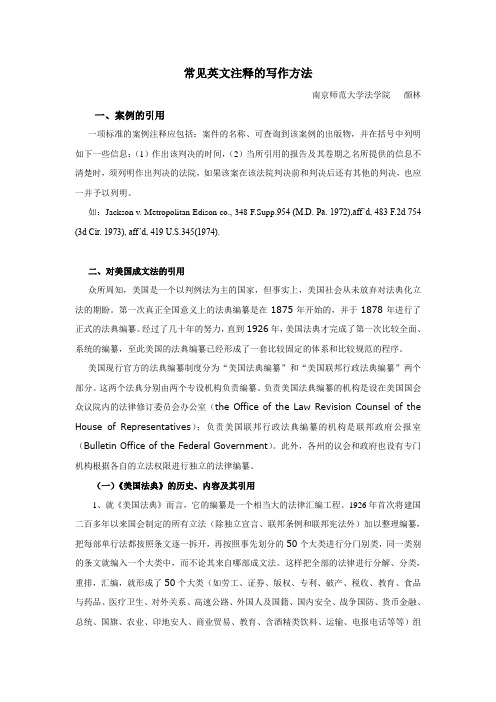
常见英文注释的写作方法南京师范大学法学院颜林一、案例的引用一项标准的案例注释应包括:案件的名称、可查询到该案例的出版物,并在括号中列明如下一些信息:(1)作出该判决的时间,(2)当所引用的报告及其卷期之名所提供的信息不清楚时,须列明作出判决的法院,如果该案在该法院判决前和判决后还有其他的判决,也应一并予以列明。
如:Jackson v. Metropolitan Edison co., 348 F.Supp.954 (M.D. Pa. 1972),aff’d, 483 F.2d 754 (3d Cir. 1973), aff’d, 419 U.S.345(1974).二、对美国成文法的引用众所周知,美国是一个以判例法为主的国家,但事实上,美国社会从未放弃对法典化立法的期盼。
第一次真正全国意义上的法典编纂是在1875年开始的,并于1878年进行了正式的法典编纂。
经过了几十年的努力,直到1926年,美国法典才完成了第一次比较全面、系统的编纂,至此美国的法典编纂已经形成了一套比较固定的体系和比较规范的程序。
美国现行官方的法典编纂制度分为“美国法典编纂”和“美国联邦行政法典编纂”两个部分。
这两个法典分别由两个专设机构负责编纂。
负责美国法典编纂的机构是设在美国国会众议院内的法律修订委员会办公室(the Office of the Law Revision Counsel of the House of Representatives);负责美国联邦行政法典编纂的机构是联邦政府公报室(Bulletin Office of the Federal Government)。
此外,各州的议会和政府也设有专门机构根据各自的立法权限进行独立的法律编纂。
(一)《美国法典》的历史、内容及其引用1、就《美国法典》而言,它的编纂是一个相当大的法律汇编工程。
1926年首次将建国二百多年以来国会制定的所有立法(除独立宣言、联邦条例和联邦宪法外)加以整理编纂,把每部单行法都按照条文逐一拆开,再按照事先划分的50个大类进行分门别类,同一类别的条文就编入一个大类中,而不论其来自哪部成文法。
视频英文文本+部分注释

How To Assemble(收集整理)A Home First Aid Kit (急救箱)Be prepared for life's little accidents and keep a well stocked(储存)home first aid kit in your house. Limit the drama of minor injuries at home by assembling your own first aid kit.You will need∙ 1 watertight box (防水盒)∙variety of bandages (绷带)∙ 1 adhesive waterproof tape (胶黏剂防水胶带)∙safety pins(别针)or bandage clips (绷带夹)∙plasters (创可贴、膏药)∙sterile gauze pads (无菌纱布垫)∙cotton wool (脱脂棉)∙eye pads(眼垫)∙non-alcoholic cleansing wipes (无酒精清洁湿巾)∙ 1 dressing scissors (敷料剪刀)∙ 1 tweezers (镊子)∙ 1 thermometer (温度计)∙1-2 pairs sterile disposable gloves (一次性无菌手套)∙ 1 face protection (防护面罩)∙ 1 cold pack (冰袋)∙ 1 heat pack (热包)∙ 1 antiseptic cream or spray (抗菌药剂或喷雾)∙non-prescription pain killers (非处方止痛药)∙antihistamine tablets (抗组织胺药片)∙ 1 notebook and penStore your medical kit somewhere immediately visible and accessible (容易取得的), but out of the reach of children.How To Perform Adult CPRCPR=Cardiopulmonary Resuscitation(心脏复苏术)CPR saves lives. Whether it helps someone you love or a stranger on the street, familiarizing yourself with these techniques can make all the difference in a life or death situation.1.Step 1: CheckFirst, you should check the scene, and then later on you're going to check the victim. (受害者)When you check the scene you want to make sure that it's safe for you. You want to make sure you do not become another victim. So, check for safety, then check for the number of victims. How many victims do you have? Clues as to what could have happened. Look around for other bystanders(旁观者)who can help you. These bystanders can help you by calling 911, stop traffic, and other things of that nature.Now, check the victim. Find out if they are unconscious. The best way to find out if the victim is conscious is to talk to them. Tap (轻拍)and shout and see if they respond to you.2.Step 2: CallIf they are unconscious or under any other life-threatening conditions, you should automatically(自觉地)call 911.Preferably, send a bystander to call 911.3.Step 3: CareCare involves the ABCs taught in Red Cross CPR classes. A is for airway(通风), B is for breathing and C is for circulation(呼吸畅通、正常呼吸)Step 4: A for Airway4.Step 5: B for BreathingIf there is no breathing, go to the "B" step, which involves 2 rescue (营救)breaths. Tilt the head back, pinch(捏)the nose, lift the chin and give two breaths. Those breaths are about 1 second long.If the breaths go in, that tells you there is no blockage(堵塞). Look over the body and see if there's any bleeding. Then, begin CPR.If the breaths did not go in, the victim is choking and the airway is obstructed(堵塞). Follow the steps for unconscious choking.5.Step 6: C for CirculationThe American Red Cross prefers that laypersons(外行)no longer check for a pulse on an adult. So, checking for circulation in a victim involves watching them for coughing, movement, or normal breathing. If there are no visible signs, rescuers should begin CPR.6.Step 7: CPRGive 30 chest compressions and 2 breaths 5 times in 2 minutes.To perform chest compressions on an adult, place the heel of one hand(掌跟)on the center of the person's chest, between the nipples.(乳头)Keeping your elbows(肘)straight, place your other hand on top of the first hand.With your shoulders above your hands, push straight down and compress the chest about 1 and a half to 2 inches.7.Step 8: Stopping CPRDo not stop after you begin CPR. Do not stop to recheck. Continue until you see signs of life. That means that the victim is moving, coughing breathing, moaning(呻吟), anything that wouldindicate that the person is alive. Please note that vomiting(呕吐)is not a sign of life. You can stop when another trained person takes over, a defibrillator(电震发生器,用来电击使心脏恢复跳动的)is ready to be used, the scene becomes unsafe, or you are physically exhausted(筋疲力尽).8.Step 9: RecoveryIf the victim shows signs of life, log roll(使病人侧卧)the victim into the recovery position with their stomach on the ground and their head to the side(在一旁), so they do not choke. Wait for rescue personnel to arrive.How To Treat Conscious Choking(清醒状态下的异物哽噎)In An Adult Or ChildLearning to spot and treat the symptoms of conscious choking can save the life of someone you care about or a stranger on the street. You'll be better prepared after watching this demonstration(示范)of how to treat conscious choking in an adult or a child.1.Step 1: Back Blows(击打)If you encounter(遇到)a situation where a person may bechoking, you need to act quickly to make sure that you get airinto the lungs. The person may start to cough. If so, encouragethem to keep coughing. Once the person can't cough anymore,they may grab their throat and that means they may not begetting any air. Ask permission to help them. If they agree thatyou can help them, perform five back blows between theirshoulder blades(肩胛骨).2.Step 2: Get In Position(摆好姿势)If the back blows DO NOT dislodge(逐出,取出)the item continue to Step 2 : Get In PositionStand behind the victim and put a foot right between their feet.Now, find the belly button(肚脐). An easy way to find the bellybutton is to move your hands from the victim's hips(髋部)to the center of their belly. Hold you finger just above the belly button and move your fist(拳头)to the same spot, thumb side against the abdomen of the victim(拇指侧对受害者的腹部). Keep your head to the side as you perform abdominal thrusts(当你推动受害人腹部时,保持头侧向一边).3.S tep 3: Abdominal Thrusts(推动腹部)Perform five abdominal thrusts in a j-shaped(J型)motion(动作)with your entire arm to force air out and dislodge the item.(使病人吐出异物)Note: If the victim happens to be pregnant, had recent surgery(外科手术), or if you cannot reach around the victim, raise the arms of the victim and put a fist in the center of the victim's chest.Place your other hand on top of your fist, and move both hands straight back into the chest of the victim.4.Continue to perform the back blows and abdominal thrusts untilthe victim begins to cough forcefully(强有力的), they start to talk, they pass out(昏倒), or until there is danger to you.5.Remembering these steps in an emergency could save a life. Werecommend(建议)everyone take a class and review these steps periodically(定期的).How To Stop A NosebleedStop a Nosebleed. Don't suffer unnecessarily with this common complaint(不要为这个常见疾病吃不必要的苦头了). Our expert advice shows the correct way to stop the discomfort of a nose bleed.You will need∙ 1 Hanky (手帕)∙ 1 ClockLean your head forward and breathe through your mouth, maintaining(持续)the pressure for ten minutes.3.Step 3: Continue to apply pressureIf the bleeding has not stopped, apply pressure for another 10 minutes.4.WARNINGWhatever you do don't tip your head back(仰头)since this will result in you swallowing blood. Or stick a key on the back of your neck… that's just an old wives' tale(无稽之谈)(!就是说,这是一个老办法,其实是没用的)5.Seek medical adviceHow To Relieve Vomiting(呕吐)Relieve Vomiting. This unpleasant sign of illness is uncomfortable to watch as well as experience. Learn how you can use several ways to relieve the symptoms.Step 1: You will need∙ 1 cloth∙drinking water1.Step 2: Comfort the person2.Step 3: Use a warm cloth4.Step 5: Avoid spicy foodFor the next 24 hours if the person feels hungry, only give easily digested non-spicy foods.5.If the vomiting persists, seek medical advice.(擦伤)Step 1: You will need∙ a pair of disposable(一次性)gloves∙some alcohol free wipes∙some sterile(无菌)gauze(纱)pads∙some sterile gauze dressing∙ a plaster1.Step 2: Clean The WoundIf the wound is dirty, clean it by rinsing(清洗)it gently under running water. This will help get rid of loose foreign particles.You can also use non-alcoholic cleansing wipes to clean the wound, but be careful to avoid wiping dirt from around the wound into it.2.Step 3: Make The Person ComfortableIf possible, help them to sit down at a table where you can put your first aid supplies.3.Step 4: Wash Your Hands ThoroughlyWash your hands thoroughly using soap and dry them. Put on a pair of disposable gloves if you have4.Step 5: Clean The Surrounding AreaNow using a clean gauze pad dipped in soapy water, wipe the surrounding area. Use cleans pads for each stroke.5.Step 6: Pat Dry And Cover WoundThen use a gauze pad to pat the wound dry and cover with sterile gauze. This will help to protect the cleaned area.6.Step 7: Apply PlasterFinally, remove the wound covering and apply a plaster to reduce the risk of infection, but first check that the person is not allergic(过敏)to the kind of plaster you're using.7.Seek Medical AdviceYour should seek medical advice if the bleeding does not stop or there is a risk of infection. Medical advice should also be sought regarding tetanus(破伤风)immunisation(免疫).How To Treat Minor Burns & Scalds(烫伤)Treat Minor Burns & Scalds. Be prepared for household accidents. Our guide will show you a quick and effective method to reduce discomfort and aid healing.Step 1: You will need∙ 1 non-stick sterile dressing∙ 1 roller bandage∙ 1 adhesive tape2.Step 3: Make the person comfortableMake the injured person comfortable. If possible, help them to sit down at a table where you can put your first aid supplies.3.Step 4: Wash hands thoroughlyNow, using soap, wash and dry your hands thoroughly and put on a pair of disposable gloves if available5.Step 6: Apply burn cream6.Read the instructions carefully before applying the burn cream.If there are any blisters be careful not to burst them, as thismight cause an infection.7.Step 7: Apply dressingCover the injured part with a non-stick sterile dressing to help stop infection. If there is blistering, make sure the dressing extends well beyond the edges of it.8.Step 8: Apply bandageNext bandage the dressing loosely in place. Watch VideoJug film ‘how to apply a roller bandage' for the full technique.9.Step 9: Check circulationOnce you have finished, check the circulation of the injured limb by pressing on one of the nails or skin of the hand until it becomes pale. Then release, and if the colour does not come back within 2 to 3 seconds, then circulation is likely to be impaired and the bandage too tight.Take the bandage off, if this doesn't improve circulation, remove all restrictive bandaging, hold dressings in place and immediately seek medical advice.10.S tep 10: Seek medical adviceYou should seek medical advice if you are worried about the severity of the burn. Be aware that when any skin is burned away there is an increased risk of infection which may develop at any point before the wound is fully healedHow To Deal With Foot Cramp(抽筋)Stop the agony of this common muscular pain and follow VideoJug's expert advice on how to deal with foot cramp and you'll be back on your feet fast. Don't let foot cramp prevent you from being active with VideoJug's help.1.Step 1: Put weight on painful footAs soon as you feel the pain of a cramp, put your body weight on the front of the affected foot2.Step 2: Walk around3.Step 3: Remove shoes and socksIf your foot is still in spasm, remove shoes, socks or any garments that may affect the cramp and bend or sit down still keeping the weight on the front of your foot.4.Step 4: Straighten your toesIf the toes are in severe spasm, from a sitting position, lift the foot slightly off the ground resting on the heel on the floor and try and to straighten your toes.5.Step 5: Massage the affected areaWhen the spasm eases gently massage the foot using your fingers until the affected area feels relaxed.6.Step 6: Pull toes backIf the cramp persists, try pulling the toes back towards you as far as they will go.7.Step 7: Repeat processFor a persistent cramp keep repeating the whole process until the pain subsides.8.If you suffer with recurring(疾病等)复发cramps, contact yourdoctor.How To Care For An Ankle InjuryAnkle injuries are notorious(有名的,臭名远扬的,臭名昭彰的,声名狼藉的。
英文图纸 土建注释
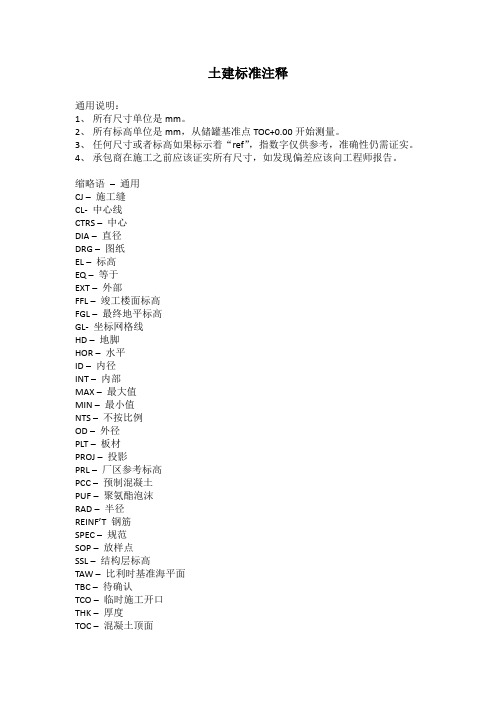
土建标准注释通用说明:1、所有尺寸单位是mm。
2、所有标高单位是mm,从储罐基准点TOC+0.00开始测量。
3、任何尺寸或者标高如果标示着“ref”,指数字仅供参考,准确性仍需证实。
4、承包商在施工之前应该证实所有尺寸,如发现偏差应该向工程师报告。
缩略语–通用CJ –施工缝CL- 中心线CTRS –中心DIA –直径DRG –图纸EL –标高EQ –等于EXT –外部FFL –竣工楼面标高FGL –最终地平标高GL- 坐标网格线HD –地脚HOR –水平ID –内径INT –内部MAX –最大值MIN –最小值NTS –不按比例OD –外径PLT –板材PROJ –投影PRL –厂区参考标高PCC –预制混凝土PUF –聚氨酯泡沫RAD –半径REINF’T 钢筋SPEC –规范SOP –放样点SSL –结构层标高TAW –比利时基准海平面TBC –待确认TCO –临时施工开口THK –厚度TOC –混凝土顶面TOG –灰浆顶面TOS –钢材顶面TPS –热保护系统TYP –相同类型UNO –除非特别注明UOC –混凝土底平面UOS - 钢材底平面U/S –底平面VER –垂直WP –工作点缩略语–钢筋位置ABR –等长相错翻转ABS - 等长相错交替排列AP - 长短交替排列B1 –底面–外层B2 –底面- 第2层B3 –底面–第3层EF –每侧ES- 同样间距EW –每个方向F1 –远面–外层F2 –远面–第2层F3 –远面–第3层LL –长钢筋N1 –近面–外层N2 –近面–第2层N3 –近面–第3层T1 –顶面–外层T2 –顶面–第2层T3 –顶面–第3层钢筋标注:。
英文注释体例
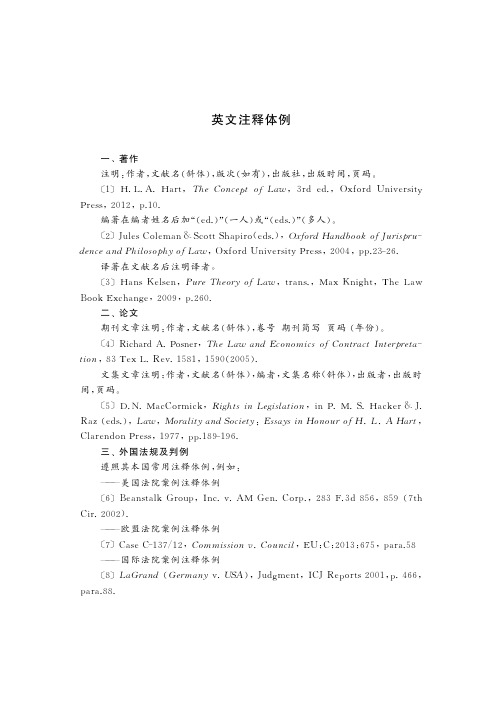
英文注释体例一、著作注明:作者,文献名(斜体),版次(如有),出版社,出版时间,页码。
〔1〕H.L.A.Hart,The Concept of Law,3rd ed.,Oxford UniversityPress,2012,p.10.编著在编者姓名后加“(ed.)”(一人)或“(eds.)”(多人)。
〔2〕Jules Coleman &Scott Shapiro(eds.),Oxford Handbook of Jurispru-dence and Philosophy of Law,Oxford University Press,2004,pp.23-26.译著在文献名后注明译者。
〔3〕Hans Kelsen,Pure Theory of Law,trans.,Max Knight,The LawBook Exchange,2009,p.260.二、论文期刊文章注明:作者,文献名(斜体),卷号期刊简写页码(年份)。
〔4〕Richard A.Posner,The Law and Economics of Contract Interpreta-tion,83Tex L.Rev.1581,1590(2005).文集文章注明:作者,文献名(斜体),编者,文集名称(斜体),出版者,出版时间,页码。
〔5〕D.N.MacCormick,Rights in Legislation,in P.M.S.Hacker &J.Raz(eds.),Law,Morality and Society:Essays in Honour of H.L.A Hart,Clarendon Press,1977,pp.189-196.三、外国法规及判例遵照其本国常用注释体例,例如:———美国法院案例注释体例〔6〕Beanstalk Group,Inc.v.AM Gen.Corp.,283F.3d856,859(7thCir.2002).———欧盟法院案例注释体例〔7〕Case C-137/12,Commission v.Council,EU:C:2013:675,para.58———国际法院案例注释体例〔8〕LaGrand(Germany v.USA),Judgment,ICJ Reports 2001,p.466,para.88. 四、辞书注明:辞书名页码(版次和出版时间)。
英文注释体例

英文文献采用“APA格式”:单一作者著作的书籍:姓,名字首字母.(年). 书名(斜体). 出版社所在城市:出版社.Sheril, R. D. (1956). The terrifying future: Contemplating color television. San Diego: Halstead.两位作者以上合著的书籍:姓,名字首字母., & 姓,名字首字母.(年). 书名(斜体). 出版社所在城市:出版社.Smith, J., & Peter, Q. (1992). Hairball: An intensive peek behind the surface of an enigma.Hamilton, ON: McMaster University Press.文集中的文章:Mcdonalds, A. (1993). Practical methods for the apprehension and sustained containment of supernatural entities. In G. L. Yeager (Ed.), Paranormal and occult studies: Case studies in application (pp. 42–64). London: OtherWorld Books.期刊中的文章(非连续页码):Crackton, P. (1987). The Loonie: God's long-awaited gift to colourful pocket change? Canadian Change,64(7), 34–37.期刊中的文章(连续页码):姓,名字首字母.(年).题目.期刊名(斜体). 第几期,页码.Rottweiler, F. T., & Beauchemin, J. L. (1987). Detroit and Narnia: Two foes on the brink of destruction. Canadian/American Studies Journal, 54, 66–146.月刊杂志中的文章:Henry, W. A., III. (1990, April 9). Making the grade in today's schools. Time,135, 28-31.。
英文注释规范

英文注释规范MLA Stylesheet英文注释:1、当首次引用一本著作的资料时,注释中须将该书的作者姓名、书名、出版地、出版者、出版年代及资料所在页码顺序注明。
具体格式如下:(1)专著类:Harold U. Faulkner, American Economic History (New York: Harper&Brothers Publishers, 1960), pp.23-25.说明:(a)作者姓名按通常顺序排列,后面加逗号;书名用斜体,手稿中可在书名下用横线标出;书名后紧接圆括号,括号内注出版地,加冒号,后接出版者名称,再加逗号,然后注出版年代;括号后面加逗号,再注出引用资料所在的页码,页码后加句号表示注释完毕;单页页码用p.表示;多页页码用pp.表示,意为pages。
(b)作者如系二人,作者姓名之间用and或&连接;如系二人以上,可写出第一作者姓名,后面加et al.表示and others,如:Donna Worrall Brown et al., Form in Modern English,其余与(a)同。
(c)著作名如有副标题,则以冒号将其与标题隔开,如:Robert K.Murray, The Harding Era: Warren G. Harding and His Administration (Minneapolis: University of Minnesota Press, 1969), p.91.(d)著作如系多卷本中的一卷,须在注明页码前,用Vol.加罗马数字标明卷数,如:Ralph F. de Bedts, Recent American History: 1945 to the Present,Vol.II (Illinois: Dorsey Press, 1973), p.169.(2)编著类:Paul M. Angle, ed., The American Reader: From ColumbustoToday (New York: Rand McNally Co.,1958), pp.52-53.说明:(a)如编者系多人,则须将ed.写成eds.,如:E. B. White &Katherine S. White, eds.,A Subtreasury of American Humor,后面的注释内容与著作类同。
《共产党宣言》英文加注释
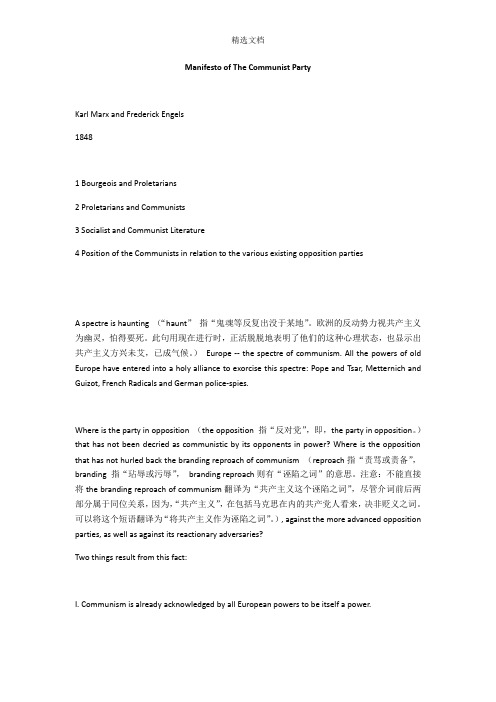
Manifesto of The Communist PartyKarl Marx and Frederick Engels18481 Bourgeois and Proletarians2 Proletarians and Communists3 Socialist and Communist Literature4 Position of the Communists in relation to the various existing opposition partiesA spectre is haunting (“haunt”指“鬼魂等反复出没于某地”。
欧洲的反动势力视共产主义为幽灵,怕得要死。
此句用现在进行时,正活脱脱地表明了他们的这种心理状态,也显示出共产主义方兴未艾,已成气候。
)Europe -- the spectre of communism. All the powers of old Europe have entered into a holy alliance to exorcise this spectre: Pope and Tsar, Metternich and Guizot, French Radicals and German police-spies.Where is the party in opposition (the opposition 指“反对党”,即,the party in opposition。
)that has not been decried as communistic by its opponents in power? Where is the opposition that has not hurled back the branding reproach of communism (reproach指“责骂或责备”,branding 指“玷辱或污辱”,branding reproach则有“诬陷之词”的意思。
英文注释及参考文献
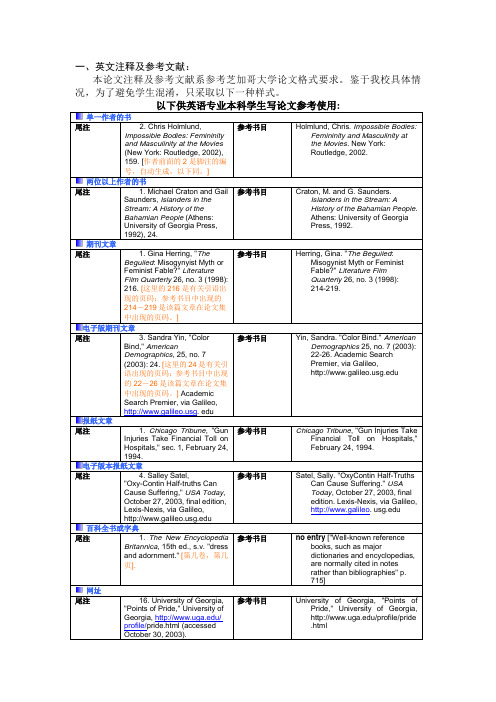
本论文注释及参考文献系参考芝加哥大学论文格式要求。
鉴于我校具体情况,为了避免学生混淆,只采取以下一种样式。
报纸文章
如果在论文中出现中文引语内容,应该比照英文引语的方式进行。
其参考文献应另列在英文的参考文献之后,不要编号。
单一作者的书
电子版期刊文章
报纸文章
网址
论文摘要
摘要是论文内容的简介,其要素有4个(目的、方法、结果和结论),必要时也可有其他重要的信息。
要以提供论文内容梗概为目的,在编写时四要素中的方法、结果和结论宜详细,重点是结论,目的可简单。
要在有限的字数内(100-150字左右)提供尽可能多的信息。
编写摘要的注意事项:
1) 要反映论文的新内容和特别强调的观点;
2) 不应对论文内容作解释和评论,尤其不应作自我评价;
3) 不要用第一人称,而应采用第三人称;
4) 不得简单地重复题名中已有的信息;
5) 一般不用引文(除非论文证实或否定了他人已出版的著作);
6) 一般不分段落;
7) 缩略语、略称、代号等,除了相邻专业的读者也能清楚理解的以外,首次出现处必须加以说明。
软件产品的英文注释
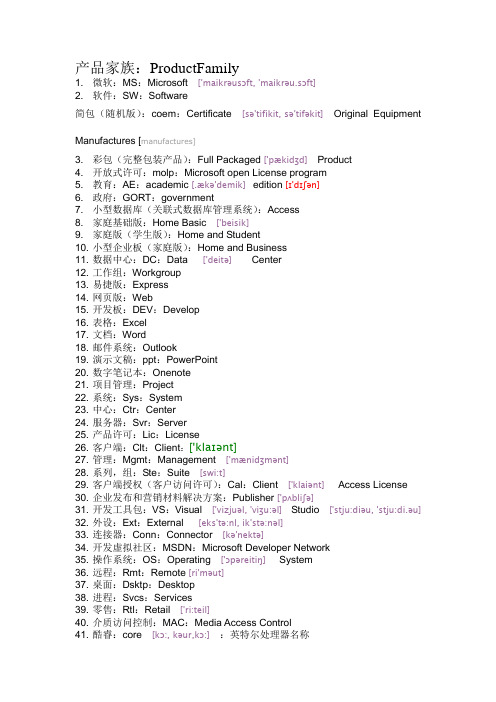
产品家族:ProductFamily1. 微软:MS:Microsoft ['maikrəusɔft, 'maikrəu.sɔft]2. 软件:SW:Software简包(随机版):coem:Certificate [sə'tifikit, sə'tifəkit]Original Equipment Manufactures [manufactures]3. 彩包(完整包装产品):Full Packaged ['pækidʒd]Product4. 开放式许可:molp:Microsoft open License program5. 教育:AE:academic[.ækə'demik]edition[ɪ'dɪʃən]6. 政府:GORT:government7. 小型数据库(关联式数据库管理系统):Access8. 家庭基础版:Home Basic ['beisik]9. 家庭版(学生版):Home and Student10. 小型企业板(家庭版):Home and Business11. 数据中心:DC:Data ['deitə]Center12. 工作组:Workgroup13. 易捷版:Express14. 网页版:Web15. 开发板:DEV:Develop16. 表格:Excel17. 文档:Word18. 邮件系统:Outlook19. 演示文稿:ppt:PowerPoint20. 数字笔记本:Onenote21. 项目管理:Project22. 系统:Sys:System23. 中心:Ctr:Center24. 服务器:Svr:Server25. 产品许可:Lic:License26. 客户端:Clt:Client:['klaɪənt]27. 管理:Mgmt:Management ['mænidʒmənt]28. 系列,组:Ste:Suite [swi:t]29. 客户端授权(客户访问许可):Cal:Client ['klaiənt] Access License30. 企业发布和营销材料解决方案:Publisher ['pʌbliʃə]31. 开发工具包:VS:Visual ['vizjuəl, 'viʒu:əl] Studio ['stju:diəu, 'stju:di.əu]32. 外设:Ext:External [eks'tə:nl, ik'stə:nəl]33. 连接器:Conn:Connector [kə'nektə]34. 开发虚拟社区:MSDN:Microsoft Developer Network35. 操作系统:OS:Operating ['ɔpəreitiŋ]System36. 远程:Rmt:Remote [ri'məut]37. 桌面:Dsktp:Desktop38. 进程:Svcs:Services39. 零售:Rtl:Retail ['ri:teil]40. 介质访问控制:MAC:Media Access Control41. 酷睿:core [kɔ:, kəur,kɔ:]:英特尔处理器名称42. 企业管理解决方案:SAP:Systems Applications and Products in DataProcessing43. 多语言:MUL:MultiLanguage44. 插件:Plus45. 管理器:Mgr:Manager46. 配置:Config:configuration[kən.figju'reiʃən]47. 操作:Ops:Operations48. 管理授权:ML:ManagementLicense49. 虚拟机监视器:VMM:Virtual ['və:tjuəl, 'və:tʃu:əl]Machine Monitor['mɔnitə, 'mɔnətə]50. 结构化查询语言:SQL:Structured ['strʌktʃəd]Query['kwiəri, 'kwiri]Language51. 中小企业套包(小型企业服务器):SBS:Small Bussiness Server52. 介质:MVL DVD定价级别:V olumeLevel无级别:NL:No Level ['levl, 'levəl]语言版本:Language简体中文:CHNS:Chinese Simplified多语言:ALNG: All Languages单语言(英文):SNGL:Single Language产品类型:ProductType基本版:Essential [i'senʃəl]高级版:Premium ['pri:miəm] Add-On [æd专业版:Pro:Professional [prə'feʃənəl]企业版:Ent:Enterprise ['entəpraiz, 'entə.praiz标准版:Std:Standard ['stændəd旗舰版:Ultimate ['ʌltimit, 'ʌltəmit。
英文注释版

英文注释版【实用版】目录1.英文注释版的概念与作用2.英文注释版的分类与形式3.英文注释版的应用领域与价值4.我国英文注释版的发展现状与挑战5.英文注释版的未来发展趋势与建议正文一、英文注释版的概念与作用英文注释版,顾名思义,是指在英文原文的基础上,添加相应的注释以方便读者理解和学习的一种文本形式。
英文注释版在很多领域具有广泛的应用,如教育、科研、翻译等,它对于提高读者的阅读理解能力、扩大词汇量和丰富知识储备具有重要的作用。
二、英文注释版的分类与形式英文注释版可以根据注释内容的不同进行分类,常见的有以下几种:1.词汇注释:针对生僻词汇、专业术语等,给出简洁明了的解释,帮助读者跨越词汇障碍。
2.语法注释:对句子结构、语法规则等进行解释,有助于读者掌握英语语法知识。
3.背景注释:对原文中涉及的历史、文化、地理等背景知识进行补充,丰富读者的知识面。
4.意义注释:对原文的隐含意义、象征意义等进行解读,帮助读者深入理解文章内涵。
三、英文注释版的应用领域与价值英文注释版在多个领域具有广泛的应用,其价值体现在:1.教育领域:英文注释版对于英语学习者来说,是提高阅读理解能力和扩大词汇量的有效工具,有助于提高学习效果。
2.科研领域:对于科研工作者来说,阅读英文文献是必不可少的。
英文注释版可以帮助他们更快速、准确地获取信息,提高工作效率。
3.翻译领域:英文注释版可以为译者提供丰富的背景知识和注释,有助于提高翻译质量。
四、我国英文注释版的发展现状与挑战我国英文注释版的发展取得了一定的成果,但仍面临一些挑战:1.发展水平不平衡:在一些领域,如教育、科研等,英文注释版的发展较为成熟,但在其他领域,如文化、艺术等,仍处于起步阶段。
2.质量参差不齐:部分英文注释版的质量不高,甚至出现错误,对读者产生误导。
3.专业人才短缺:英文注释版的发展需要大量具备专业知识和英语水平的人才,但我国目前这方面的人才仍然不足。
五、英文注释版的未来发展趋势与建议面对挑战,我国英文注释版的未来发展应注重以下几个方面:1.加强政策支持,提高行业标准,促进英文注释版在各领域的均衡发展。
英文注释的写作要求
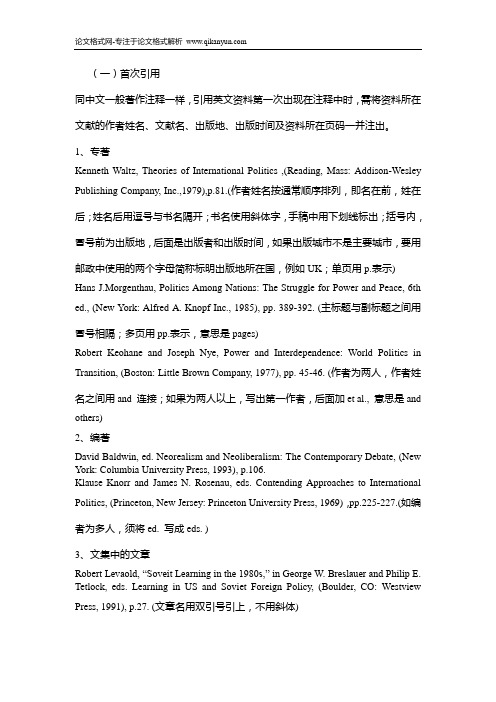
(一)首次引用同中文一般著作注释一样,引用英文资料第一次出现在注释中时,需将资料所在文献的作者姓名、文献名、出版地、出版时间及资料所在页码一并注出。
1、专著Kenneth Waltz, Theories of International Politics ,(Reading, Mass: Addison-Wesley Publishing Company, Inc.,1979),p.81.(作者姓名按通常顺序排列,即名在前,姓在后;姓名后用逗号与书名隔开;书名使用斜体字,手稿中用下划线标出;括号内,冒号前为出版地,后面是出版者和出版时间,如果出版城市不是主要城市,要用邮政中使用的两个字母简称标明出版地所在国,例如UK;单页用p.表示) Hans J.Morgenthau, Politics Among Nations: The Struggle for Power and Peace, 6th ed., (New Y ork: Alfred A. Knopf Inc., 1985), pp. 389-392. (主标题与副标题之间用冒号相隔;多页用pp.表示,意思是pages)Robert Keohane and Joseph Nye, Power and Interdependence: World Politics in Transition, (Boston: Little Brown Company, 1977), pp. 45-46. (作者为两人,作者姓名之间用and 连接;如果为两人以上,写出第一作者,后面加et al., 意思是and others)2、编著David Baldwin, ed. Neorealism and Neoliberalism: The Contemporary Debate, (New Y ork: Columbia University Press, 1993), p.106.Klause Knorr and James N. Rosenau, eds. Contending Approaches to International Politics, (Princeton, New Jersey: Princeton University Press, 1969),pp.225-227.(如编者为多人,须将ed. 写成eds. )3、文集中的文章Robe rt Levaold, “Soveit Learning in the 1980s,” in George W. Breslauer and Philip E. Tetlock, eds. Learning in US and Soviet Foreign Policy, (Boulder, CO: Westview Press, 1991), p.27. (文章名用双引号引上,不用斜体)4、期刊杂志中的文章Joseph S. Nye, “Nuclear learning and US-Soviet Security Regimes,” International Organization, vol. 41 (Summer 1987), p.4 (期刊名用斜体41表示卷号)Rafael V,如注释紧挨着,可以用Ibid.代替作者姓名、著作名。
hamlet 英文词频统计注释
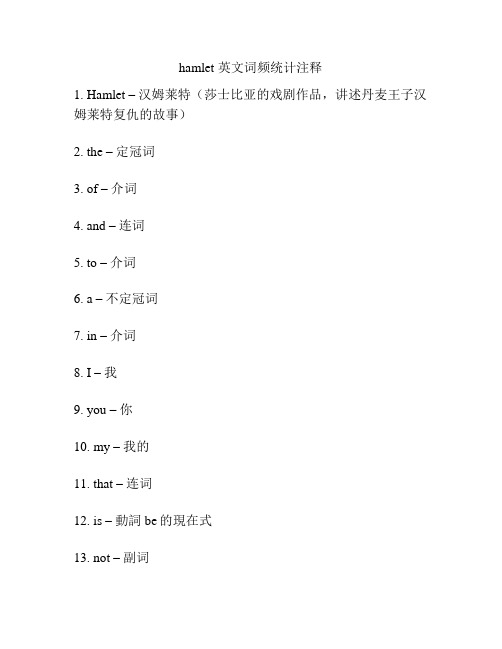
hamlet 英文词频统计注释1. Hamlet –汉姆莱特(莎士比亚的戏剧作品,讲述丹麦王子汉姆莱特复仇的故事)2. the –定冠词3. of –介词4. and –连词5. to –介词6. a –不定冠词7. in –介词8. I –我9. you –你10. my –我的11. that –连词12. is –動詞be的現在式13. not –副词14. with –介词15. it –它16. his –他的17. but –连词18. s –的缩写形式19. for –介词20. be –動詞be的原形21. on –介词22. this –这个23. have –動詞have的原形24. thy –你的25. me –我26. so –副词27. will –動詞will的原形28. all –全部的29. are –動詞be的現在式30. her –她的31. Ham. – Hamnet或Hamlet(可能是莎士比亚儿子的名字,在该剧中没有用到)32. no –没有33. be. –的缩写形式34. as –作为35. but. –不过36. O –哦37. what –什么38. so. –如此39. their –他们的40. would –動詞will的过去式41. there –那里42. if –如果43. A –一44. or –或者45. by –由46. we –我们47. thee –你48. Oph. –奥菲利亚(汉姆莱特的女友)49. King. –国王(丹麦国王,汉姆莱特的叔叔)50. Laer. –拉尔忒斯(奥菲利亚的哥哥)。
10天背诵英文10000单词教程注释

10天背诵英文10000单词◎教程注释Lesson 11.huddle v.拥挤, 卷缩, 草率从事, 挤作一团n.杂乱的一堆, 拥挤2.censure v.责难n.责难3.vaccine adj.疫苗的, 牛痘的n.疫苗4.eradicate v.根除5.barbarian n.粗鲁无礼的人, 野蛮人adj.野蛮的, 粗鲁的6.defile v.染污n.隘路7.stable n.厩:家畜,尤指马和牛的圈养和喂食的棚子8.abdomen n.腹, 腹部9.bereft adj.被剥夺的, 失去亲人的, 丧失的10.bereave vt. 剥夺, 使失去adj. Suffering the loss of a loved one:忍受失去所爱之人后的痛苦的11.consecrate vt.用作祭祀, 献给, 使神圣adj.被献给神的, 神圣的12.consecrated adj.神圣的, 被视为神圣的13.jolt v.摇晃n.摇晃14.bow n.弓, 乐弓, 弓形, 鞠躬, 船首v.鞠躬, 弯腰15.obsolete adj.荒废的, 陈旧的n.废词, 陈腐的人16.prowl v.巡游17.scoope n.铲子v.掘, 挖18.diplomat n.外交官, 有外交手腕的人, 有权谋的人19.beloved adj.心爱的n.所爱的人, 爱人20.bandit n.强盗21.rug n.(小)地毯, 垫子22.deviation n.背离罗盘偏差:指南针由于局部磁场的影响发生偏移,尤指在船上23.tolerable adj.可容忍的, 可以的24.fortitude n.坚韧25.inconsolable adj.无法安慰的, 极为伤心的26.nibble n. 细咬, 轻咬, 啃v.一点一点地咬, 细咬, 吹毛求疵27.coronation n.加冕礼coronate vt.加冕28.pageant n.盛会, 庆典, 游行, 虚饰, 露天表演29.scourge n.鞭, 笞, 苦难的根源, 灾祸vt.鞭打, 痛斥, 蹂躏30.tumble n.跌倒, 摔跤, 翻斤斗vi.翻倒, 摔倒, 倒塌, 滚动, 翻筋斗, 仓惶地行动vt.使摔倒, 使滚翻, 弄乱pass n.罗盘, 指南针,圆规v.包围32.malicious adj.怀恶意的, 恶毒的33.inauguration n.就职典礼, 开幕式inaugurate vt.举行就职典礼, 创新, 开辟, 举行开幕(落成、成立)典礼.34.afflict vt.使痛苦, 折磨35.dissimulation n.掩饰, 虚伪, 装糊涂36.inhumane adj.残忍的37.flog vt.鞭打, 鞭策, 迫使, 驱使, 严厉批评38.disobedient adj.不服从的39.inscription n.题字, 碑铭40.rummage v.到处翻寻, 搜出, 检查n.翻箱倒柜的寻找, 检查, 零星杂物41.spout n.喷管, 喷口, 水柱, 喷流, 管口v.喷出, 滔滔不绝地讲, 喷涌42.spout out 喷出43.traverse n.横贯, 横断, 横木, 障碍, 否认, 反驳, (建筑)通廊vt.横过, 穿过, 经过, 在...来回移动, 反对, 详细研究vi.横越, 横断, 旋转, 来回移动adj.横断的, 横的44.slope n.斜坡, 斜面, 倾斜v.(使)顺斜45.wistful adj.渴望的, 想望的46.unduly adv.不适当地, 过度地, 不正当地47.meddle v.管闲事48.meddle with 干涉49.amicable adj.友善的, 和平的50.blizzard n.大风雪51.glimmer 暗淡或微弱的闪光52.lump n.块(尤指小块), 肿块, 笨人vt.使成块状, 混在一起, 忍耐, 笨重地移动vi.结块53.ransack vt.到处搜索, 掠夺, 洗劫54.slash(1)乱砍:slash a path through the underbrush.从灌木丛中劈出一条路来(2) 尖刻地批评:The work of the composer has been slashed by the reviewers. 批评家严厉地批评这名作曲家的作品more....55.slumpv.(1)To fall or sink heavily; collapse: 掉入,陷入:沉重地落下或沉下;倒塌:She slumped, exhausted, onto the sofa. 她疲惫之极地倒在沙发上(2)懒散的座着、站着:坐着或站着时垂下;耷拉着(3)To decline suddenly; fall off: 暴跌:突然下降;衰退:Business slumped after the holidays. 节日过后生意下降了(4)To sink or settle, as into mud or slush.( n.烂泥v.溅湿) 陷入:沉入或陷入(泥泞或雪泥中)(5)To slide down or spread out thickly, as mud or fresh concrete. 滑落:将(泥或新拌的混凝土)厚厚地滑下或涂抹开n.(1)The act or an instance of slumping. 陷入,掉入:沉下的动作或事(2)A drooping or slouching posture: 垂下,萎靡:低垂或颓丧的姿式:read defeat in the slump of his shoulders. 从他肩膀的无力下垂上可以看出他失败了(3)A sudden falling off or decline, as in activity, prices, or business: 暴跌:(活动、价格或生意方面)突然的衰退或下降:a stock market slump; a slump in farm prices. 股市暴跌;农产品降格陡降(5)An extended period of poor performance, especially in a sport or competitive activity: 低潮:一段很长的差劲的表演,尤指体育活动或竞赛中:a slump in a batting average. 击球率的低潮期56.carry off v. 夺去...的生命, 获得, 成功对付57.mammalian n.哺乳动物adj.哺乳动物的58.ascribe vt.归因于, 归咎于59.bulwark n.壁垒, 防波堤60.dubious adj.可疑的, 不确定的61.heed n.注意, 留意v.注意, 留意62.mumble n.喃喃而语, 咕哝, 闭嘴细嚼v.喃喃而语, 咕哝63.relic n.遗物, 遗迹, 废墟, 纪念物64.exhaust vt.用尽, 耗尽, 抽完, 使精疲力尽vi.排气n.排气, 排气装adj.用不完的, 不会枯竭的65.fume n.(浓烈或难闻的)烟, 气体, 一阵愤怒(或不安) v.用烟熏, 冒烟, 发怒66.wayfarer n.旅客, 徒步旅行者(同:hiker)67.wont n.习惯, 惯常活动adj.惯于, 常常vi.习惯vt.使习惯于Lesson 268.absolve v.宣布免除69.umpire n.仲裁人, 裁判员v.仲裁, 任裁判, 作裁判70.contend v.(动词)con.tend.ed,con.tend.ing,contendsv.intr.(不及物动词)(1)To strive in opposition or against difficulties; struggle: 争斗:对抗性地或与困难相斗争;斗争:armies contending for control of strategic territory; had to contend with long lines at the airport.军队为了控制战略领地而奋战;在机场必须忍受大排长龙(2)To compete, as in a race; vie. 竞争,如在竞赛中;争夺(3)To strive in controversy or debate; dispute.See Synonyms at discuss争论:在争论或辩论中据理力争;辩论参见discussv.tr.(及物动词)(4)To maintain or assert: 主张或声称:The defense contended that the evidence was inadmissible. 被告方声称证据是不可接受的71.deplore v.表示悲痛72.fracture n.破裂, 骨折v.(使)破碎, (使)破裂73.pith n.(植物的)木髓, 骨髓, 重要部分, 核心, 意义, 精华, 精力vt.除去木髓, 杀死74.relish n.(名词)(1)An appetite for something; a strong appreciation or liking: 胃口:对某事物的食欲,强烈的欣赏或者喜欢:a relish for luxury.对奢侈品的爱好(2)Hearty enjoyment; zest.See Synonyms at zest 诚恳的享乐;风味参见zest(3)Something that lends pleasure or zest. 独特的滋味:使人感到愉快或有风味的东西(4)A spicy or savory condiment or appetizer, such as chutney or olives.调味品:加有香料的或开胃的佐料或开胃品,如辣酱或者橄榄(5)A condiment of chopped sweet pickle. 切碎的甜泡菜做的调味品(6)The flavor of a food, especially when appetizing.See Synonyms at taste滋味:食物的味道,特别是促进食欲的味道参见taste(7)A trace or suggestion of a pleasurable quality. 滋味:令人愉快的微量或意味v.(动词)rel.ished,rel.ish.ing,rel.ish.esv.tr.(及物动词)(1)To take keen or zestful pleasure in.See Synonyms at like 1欣赏:从…中得到敏锐的热烈的欢愉参见like1(2)To enjoy the flavor of. 品尝:品尝…的味道(3)To give spice or flavor to.给…加佐料v.intr.(不及物动词)(1)To have a pleasing or distinctive taste. 有滋味:有令人愉快的或特定的味道75.whip n.鞭子, 车夫v.鞭打, 抽打, 突然移动76.tidings n.消息77.cumber v.tr.(及物动词)cum.bered,cum.ber.ing,cum.bers(1)To weigh down; burden: 压下;使挑重担:was cumbered with many duties. 肩负许多重任(2)To hamper or hinder, as by being in the way: 妨碍,阻碍:妨碍或阻碍,如挡在路上:was cumbered with a long poncho. 披风过长行动就会不便(3)To litter; clutter up: 使凌乱;使塞满:Weeds cumbered the garden paths. 花园小径上到处都是杂草。
英文注释

给药前prior to treatment详细临床观察前 Prior to Clinical Observations心电 ECG 体温Body temperature 去毛Shaving信息删除Information deletion信息更正Information correction信息添加Information addition拼写错误Spelling mistakesDaily Animal Cageside Observations / 动物日常笼边观察A - No Visible Abnormalities / 无明显异常I - Food Offered / 给过饲料J - Water Offered / 给过水B - Abnormalities Found; Refer to Detailed Clinical Observation form / 发现异常:请参考详细临床观察表C - Animal Found Dead; Refer to Detailed Clinical Observation form / 已死亡的动物:请参考详细临床观察表D - Animal Found Outside of Cage; Refer to Study Director Notification / 在笼外面的动物:请参照专题负责人通知E - Food and Water Available / 有足够食物和水F - Animals fasted for study, but water available / 动物禁食,但不禁水G - Both water and food removed for study purposes / 因试验需要水和食物均不提供H - Water Available and Food Refer to SOP. /有足够的水,依据SOP给食。
体重 Body weights砝码编号Reference Weights No.: LSA-REW-耗食量Food Start/Food EndE - Excluded (A reason for exclusion must be documented) / 被排除在外(必须注明被排除原因)溢出Spillage破损Breakage湿饲料Wet FeedD - Animal died prior to collection of data / 数据收集前动物死亡详细临床观察Clinical Observations详细临床观察前Prior to Clinical ObservationsC - Palpable Tissue Mass(es) Present - Refer to the Palpable Tissue Mass Locations Form / 出现可触及肿块-参考肿块定位表未发现粪便No feces were found.约5ml白色泡沫About 5 ml White foam食物残渣Feed residue包含食物containing food泡沫状foamy液体liquidBasal Laboratory Diet Administration / 动物饲料基础信息领用25kg饲料投入使用25KG diets put in the room.A - Beijing Keao Xieli Feed Co.,Ltd./北京科澳协力饲料有限公司B - Qingdao Kangda Biological Technology Co.,Ltd./青岛康大生物科技有限公司C - Beijing Huafukang Bioscience Co.,Inc./北京华阜康生物科技股份有限公司M - Remaining Diet Discard / 多余饲料丢弃N - Use up / 用完E - Canine Maintenance Feed/犬维持饲料F - SPF Guinea Pig Growth and Reproduction Feed/SPF豚鼠生长繁殖饲料G - Primate Formula Feed/实验猴配合饲料H- SPF Rabbit Special Feed/SPF级实验兔专用饲料I - SPF Rodent Growth and Reproduction Feed/SPF大小鼠生长繁殖饲料J - Swine Maintenance Feed/实验用猪维持饲料K - SPF Rabbit Growth and Reproduction Feed/SPF兔生长繁殖饲料L - SPF Hamster Grouth and Reproduction Feed/SPF地鼠生长繁殖饲料Disposition / 处置:A - Physical abnormality /身体异常B - Excluded by randomization process / 随机排除的动物P - Animal assigned to study / 纳入研究动物E - Euthanized and Discarded via ___________ (method) / 通过__________ (方法)安乐死,丢弃F - Animal used as replacement; refer to replacement animal disposition / 替换动物; 参阅"替代动物处置"G- Cervical dislocation / 颈椎脱臼2 - Prior to euthanasia / 安乐死前1 - Assigning permanent number / 做永久编号4 - Prior to necropsy / 解剖前3 - Prior to blood, urine, or feces collection / 收集血液、粪尿前6 - Found Dead / 发现死亡5 - Following blood collection / 间段性血液收集8 - Found outside of cage / 动物逃出饲养笼7 - Transferring cages / 更换饲养笼17 - Transferred to Necropsy / 转移至解剖组9 - Assigning temporary number and placement into initial housing / 做临时编号、初始安置10 - Prior to ECG examination/blood pressure measurement / 心电图、血压测量前Reasons for Replacement / 替换原因:A - Physical Abnormality / 身体异常B - Animal Found Dead / 动物死亡C - Euthanized in Extremis / 濒临死亡D - Animal Outside Specified Body Weight Range / 动物超出规定体重范围P - Animal Assigned to Study as Replacement Animal / 作为替换动物分配到课题中H - Euthanized and Discarded / 处死并丢弃I - Found Dead and Discarded / 死亡并丢弃动物发现死亡,转移至解剖The animal was found dead and transferred to NEC.设备更换Equipment Change塑料骨头Plastic Bone不锈钢圆筒Stainless Steel Tube代谢笼Metabolism Cage(玉米芯垫料)批号Lot number:动物笼更换Transferring cages更换饲养笼After Transferring cagesA - Food Containers / 食物器皿B - Water Containers / 水瓶C - Animal Caging / 动物笼D - Food Storage Containers / 食物贮存器皿E - Garbage Containers / 垃圾桶F - Enrichment (if used include which type in the comments section) / 玩具(若使用,需在评论中说明是哪种类型)G - Biohazard Containers / 生物有害性物质容器H - Bedding / 垫料I - Water Storage Container / 储水容器J - Cage Shelf / 笼架K - Footrest / 踏板:给药Treatment约ml动物饮用水About ml animal drinking water.空白胶囊1粒One blank capsule胶囊1粒One capsule片剂1片One Tablet给药前轻轻摇匀Shaked slowly before doing.给药前涡旋混匀Vortex mixed before dosingAmount to be dosed / 给药量Dosing Time* / 给药时间*营养品&视觉丰富水果Fruits西瓜watermelon梨pearTelevision Enrichment / 影片观看记录观看影片:海底总动员,开始时间:。
英文注释

Bus Logic 总线逻辑
Lsi Logic 大规模集成电路逻辑
SCSI Adapter小型电脑系统接口 适合
5.VP(Voice Platform),是排队机的语音资源站点,为业务提供放音/收号/录音/TTS/ASR资源,通过中继或者HW、CDC转换板和排队机网板相连。在ICD系统中通常将常用提示音放在文件服务器上。
SONET(Synchronous Optical Network)是ANSI定义的同步传输体制,是一种全球化的标准传输协议,采用光传输,传输速率组成一个序列,包括STM-1(155Mbit/s)、STM-4c(622Mbit/s)和STM-16c/STM-16(2.5Gbit/s),每一级速率都是较低一级的4倍。由于是同步信号,因此SDH可以方便地实现多路信号的复用。
30.Instance 实例:类实例化以后成为一个对象。
17.ISDN(Integrated Service Digital NeTwork)中文名称是综合业务数字网,通俗称为“一线通”。
18.VCS(VCS --Veritas Cluster Server)是VERITAS公司开发的一款高可用多机热切换软件,可以通过应用在各服务器之间的智能化灵活切换,使多台服务器协同工作,支持Unix和Windows NT环境。作为多机的集群软件,VCS对应用的切换具有速度快、方式灵活的特点。在SAN环境下,VCS可以支持最多32台服务器协同工作,在各种群集管理软件中优势突出,是目前扩展性最好高可用软件。VCS还提供Windows NT控制工具和界面。管理员可以做到无人现场值守即可监控群集的状态。 VCS目前实现了32个节点的cluster系统,即将实现128个节点的cluster能力,在各种cluster软件中力拔头筹。VCS实现真正意义的应用级切换。整个系统内的所有资源,按照应用类型分成组,当一个节点运行多个应用时,VCS按照多个应用组进行检测,某一应用故障时,仅仅将此应用组进行切换,无需干预正常的应用组。
- 1、下载文档前请自行甄别文档内容的完整性,平台不提供额外的编辑、内容补充、找答案等附加服务。
- 2、"仅部分预览"的文档,不可在线预览部分如存在完整性等问题,可反馈申请退款(可完整预览的文档不适用该条件!)。
- 3、如文档侵犯您的权益,请联系客服反馈,我们会尽快为您处理(人工客服工作时间:9:00-18:30)。
英文注释:
1、当首次引用一本著作的资料时,注释中须将该书的作者姓名、书名、出版地、出版者、出版年代及资料所在页码顺序注明。
具体格式如下:
(1)专著类:
Harold U. Faulkner, American Economic History (New York: Harper&Brothers Publishers, 1960), pp.23-25.
说明:(a)作者姓名按通常顺序排列,后面加逗号;书名用斜体,手稿中可在书名下用横线标出;书名后紧接圆括号,括号内注出版地,加冒号,后接出版者名称,再加逗号,然后注出版年代;括号后面加逗号,再注出引用资料所在的页码,页码后加句号表示注释完毕;单页页码用p.表示;多页页码用pp.表示,意为pages。
(b)作者如系二人,作者姓名之间用and或&连接;如系二人以上,可写出第一作者姓名,后面加et al.表示and others,如:Donna Worrall Brown et al., Form in Modern English,其余与(a)同。
(c)著作名如有副标题,则以冒号将其与标题隔开,如:Robert K.Murray, The Harding Era: Warren G. Harding and His Administration (Minneapolis: University of Minnesota Press, 1969), p.91.(d)著作如系多卷本中的一卷,须在注明页码前,用Vol.加罗马数字标明卷数,如:Ralph F. de Bedts, Recent American History: 1945 to the Present,Vol.II (Illinois: Dorsey Press, 1973), p.169.
(2)编著类:
Paul M. Angle, ed., The American Reader: From ColumbustoToday (New York: Rand McNally Co.,1958), pp.52-53.
说明:(a)如编者系多人,则须将ed.写成eds.,如:E. B. White &Katherine S. White, eds.,A Subtreasury of American Humor,后面的注释内容与著作类同。
(b)既有编者又有著者的著作,须将著者姓名置于书名前,编者姓名置于书名后,如:George Soule, Prosperity Decade: From War to Depression, 1917-1929 (eds. Henry David et al., New York: M. E. Sharpe, Inc., 1975), p.235.亦可不注编者,按著作类注释处理。
(3)文集内文章:
Erwin Panofsky, “Style and Medium in the Motion Picture,” Problems in Aesthelics, ed. Morris Weitz (New York: Harcourt, Brace and World, Inc., 1969), p.326.
说明:(a)文章名不用斜体或划线,与其后的逗号均置于引号内。
(b)书名采用斜体,后面注出编者姓名,格式与编著类(b)相同。
(4)报刊文章类:
Constance M. Drake, “An Approach to Blake,” College English, XXIX (April 1968), pp.541-543.
“Reading Teachers Put on Spot,” The Kansas City Star, May 1, 1969, p.16 A.
说明:(a)第一例为引用期刊中署名文章的注释,期刊名称用斜体,卷号须用罗马数字标明,然后在圆括号内注出版日期;不必注编者、出版者和出版地。
(b)第二例为引用报纸中不署名文章的注释,报纸名称用斜体,后面注出版日期。
(5)电子信息类:
如使用因特网上的资料,须注明资料所在站点详细地址
如:/antitrust/boeing.html。
2、再次引用已引用过的著作时,注释格式如下:
(1)仅注出作者姓名、页码即可,如:
Soule, p.229.
E. White &K. White, eds., p.45.
(2)如在一篇文章中,引用了同一作者的两本(篇)或两本(篇)以上的著作,则须加注书名
如:Soule, Prosperity Decade, p.134.
(3)本注与紧邻之上注所引资料出于同一著作,可以ibid.代替,意为“引书同上”或“出处同上”(如本注所引著作并非与紧邻之上注、而是与间隔之上注相同,则不可用ibid.代替),如:③Harold U. Faulkner, American Economic History (New York: Harper &Brothers Publishers, 1960), pp.23-25.
④Ibid., p.51(意为与注释③引书相同,页码不同)
⑤Ibid.(意为与注释④引书及页码都相同)。
